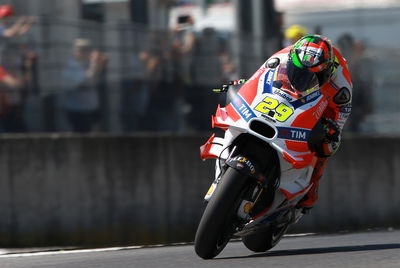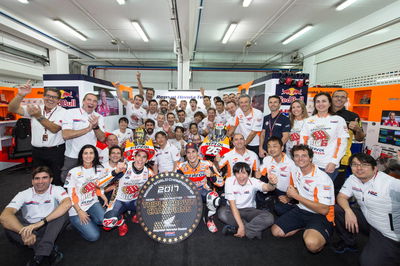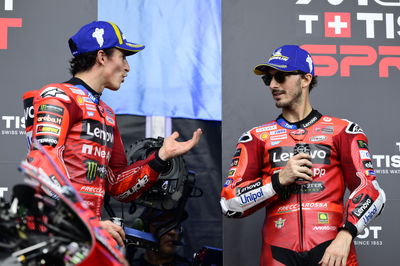MotoGP top speed evolution
Mugello, home of the Italian Grand Prix, holds the all-time MotoGP top speed record of 354.9km/h (220.5mph), by Ducati's Andrea Iannone in 2016.
The graph below shows how the maximum speed during the Italian Grand Prix weekend has changed from 1999-2017.
While slipstreaming and wind direction play a part, top speed growth has been fairly steady since 2012 and the general trend since the start of the MotoGP era (2002) has been an average increase of 10km/h every 4-5 years.

Mugello, home of the Italian Grand Prix, holds the all-time MotoGP top speed record of 354.9km/h (220.5mph), by Ducati's Andrea Iannone in 2016.
The graph below shows how the maximum speed during the Italian Grand Prix weekend has changed from 1999-2017.
While slipstreaming and wind direction play a part, top speed growth has been fairly steady since 2012 and the general trend since the start of the MotoGP era (2002) has been an average increase of 10km/h every 4-5 years.
The present prototypes now eat-up the undulating Mugello straight 35km/h faster than the last of the 500s.
Italian MotoGP weekend top speeds: 1999-2017. Present prototypes now 35km/h faster than last of the 500s...#MotoGP pic.twitter.com/fKF1ZrPmz8
— CRASH.NET/MotoGP (@crash_motogp) January 12, 2018
Some of the biggest top speed changes have unsurprisingly followed tweaks to the technical rules. The last three years of 500cc saw top speeds largely static at just below 320km/h, but within three-seasons the new 990cc four-strokes had topped 343km/h.
Speeds then tailed off - possibly due to an increasing emphasis on rideability after Valentino Rossi and Yamaha's 2004 title success, on a 'big bang' M1 that was usually only mid-pack in terms of top speed - before an 11km/h drop caused by the switch to 800cc machines in 2007.
The pursuit of raw power with the small engines (Ducati and Casey Stoner won on a 'screamer' in 2007) saw speeds rise once again and the biggest single-year leap from 2008 to 2009 when Dani Pedrosa clocked 349.3km/h on his Repsol Honda.
"It's clearly a fast straight here, although I didn't think the top speed was that high until I saw it on the timing screens," admitted Pedrosa.
Given the size of the speed increase, some at the time suspected a glitch in the figures, with rumours that the team's on-board telemetry from Pedrosa's bike did not match the speed recorded by timekeeping.
However, following detailed checks by specialists at Dorna, the speed was confirmed – and with Pramac Ducati's Mika Kallio just 0.2km/h slower in the same session (Free Practice 1).
Home manufacturer Ducati has set the top speed at every Italian Grand Prix since.
Following the change to 1000c engines in 2012, albeit with new limits on bore and stroke, top speeds have risen by small amounts in four of the six seasons. The trend-line as plotted by excel suggests the 360km/h barrier will be breached by 2020.
Is that a big problem?
"Top speed is of course a concern. But we have to be not too emotional about it," MotoGP Director of Technology Corrado Cecchinelli previously told Crash.net. "Top speed numbers are big and so they scare, but it is very rare that you have an accident at top speed.
"So top speed is a concern, but it is not the most dangerous scenario in terms of an accident."
Nevertheless, there are limits to the size of circuit run-off and, "we would like to have a medium-term plan to, if not reduce, at least 'roof' top speed. There are very easy ways to do it, which the manufacturers do not like."
Cecchinelli's top speed solution would be a rev limit, however it has "already been proposed in the past and not accepted [by the manufacturers]."
The Italian said that a rev limit would not only reduce top speed, but also engine costs and close the gap between the front and back of the field.
Meanwhile, reducing the fuel limit would not have a meaningful impact.
"According to my knowledge it is very difficult to save fuel in top power. Normally they save fuel under braking and acceleration. So I don't think it will make a big difference in top speed," Cecchinelli explained.
Another possibility is that the manufacturers will trim their own top speeds due to use of the new, bulkier, wing-fairings.
The current deal between MotoGP and the manufacturers stipulates no further changes to the technical rules until 2021, unless there is unanimous agreement or for safety reasons.
Italian MotoGP weekend top speeds: 1999-2017
2017: 354.7km/h Pirro (Ducati ) MotoGP 1000cc
2016: 354.9 Iannone (Ducati) MotoGP 1000cc
2015: 350.8 Iannone (Ducati) MotoGP 1000cc
2014: 349.6 Iannone (Ducati) MotoGP 1000cc
2013: 344.6 Iannone (Ducati) MotoGP 1000cc
2012: 346.9 Rossi (Ducati) MotoGP 1000cc
2011: 335.7 Barbera (Ducati) MotoGP 800cc
2010: 345.7 Barbera (Ducati) MotoGP 800cc
2009: 349.3 Pedrosa (Honda) MotoGP 800cc
2008: 330.8 Melandri (Ducati) MotoGP 800cc
2007: 323.3 Stoner (Ducati) MotoGP 800cc
2006: 334.0 Stoner (Honda) MotoGP 990cc
2005: 340.5 Checa (Ducati) MotoGP 990cc
2004: 343.0 Barros (Honda) MotoGP 990cc
2003: 332.4 Capirossi (Ducati) MotoGP 990cc
2002: 324.5 Ukawa (Honda) MotoGP
2001: 315.6 Rossi (Honda ) 500cc
2000: 317.8 McCoy (Yamaha) 500cc
1999: 318.6 Biaggi (Yamaha) 500cc
Official figures from Dorna.












